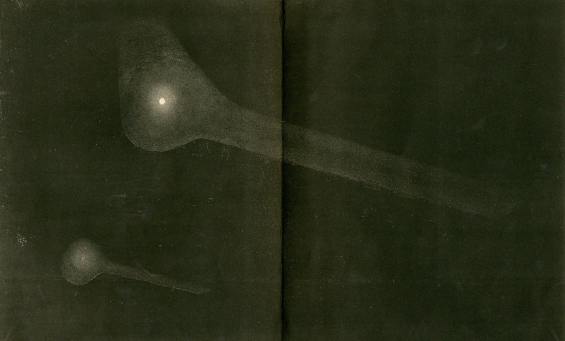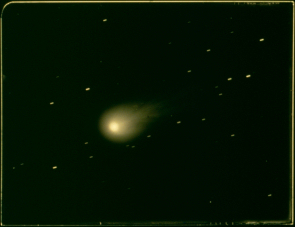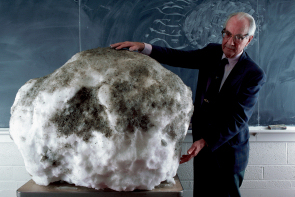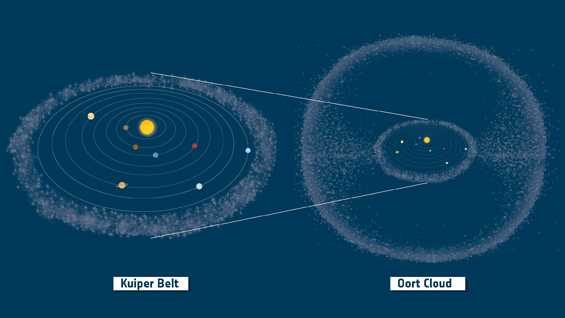A History of Comets - Part 3
On the origin of comets
A major step forward in the understanding of how comets formed came from German philosopher Immanuel Kant, who wrote his General History of Nature and Theory of the Heavens in 1755, before he turned his attention to mainly philosophical issues. In this early work, Kant suggested that the Sun and its planets formed from an extended, diffuse nebula and that comets, too, originated from this cloud.
Kant's "nebular hypothesis" was embraced and developed by French scientist Pierre-Simon Laplace. In 1805 he published his Celestial Mechanics, a seminal work about the Solar System where he also described its formation from the gravitational collapse of a primordial cloud of gas. However, Laplace could not find a place in this work for the highly eccentric orbits of comets, nor the almost random directions from which they seem to appear in the sky. He therefore argued for an interstellar origin, with comets streaking inwards from far beyond our Solar System.
This view prevailed until the second half of the nineteenth century, when astronomers discovered that the Sun – and by extension our whole Solar System – moves through our Galaxy. If comets were interstellar objects, we would see an excess of comets coming from the direction of the Sun's motion as it moves through interstellar space... but we do not. This spurred Italian astronomer Giovanni Schiaparelli to suggest that comets belong to the Solar System and surround the Sun in an almost uniform cloud – a view that became generally accepted only some decades after it was proposed.
Showers in the sky
The nineteenth century saw the discovery of many more periodic comets like the famous Halley's Comet. In 1819, German astronomer Johannes Encke realised that four comets that had been observed in the previous few decades might be the same object returning on a periodic orbit. He computed the comet's orbit, estimated its period to be 3.3 years, and correctly predicted its return in 1822. Astronomers have referred to it as Encke's Comet ever since.
Shortly after, in 1826, Austrian infantry captain Wilhelm von Biela discovered another such comet. With an estimated period of almost seven years, Biela's Comet came back right on schedule in 1832. The comet was observed to split into two pieces during its subsequent return in 1846, and both pieces were observed again for a final time in 1852.
 |
| The two fragments of Biela's comet observed in 1846, in a drawing by Otto Struve. Credit: University of Cambridge, Institute of Astronomy. |
The 1852 visit may have been the swansong for Biela's Comet, but this disintegrating body put on a different celestial show some years later. When a meteor shower was observed in 1872, while Earth was passing very close to this comet's orbit, astronomers realised that the "shooting stars" were nothing but debris produced by the comet's disintegration. Although a causal link between comets and meteor showers had been suggested a few decades earlier to explain the spectacular Leonid and Perseid meteor showers, the observation of Biela's Comet and its relics provided the first robust proof.
As for the physical properties of these wandering bodies, new clues were unveiled during the 1835 return of Halley's Comet, when German astronomer Friedrich Bessel observed streams of vapour emanating from the comet's nucleus. In his Physical Theory of Comets, Bessel argued that the force exerted by these jets must modify the orbit of the comet and cause its period to shorten from one orbit to the next – something that had been observed in Encke's Comet a few years earlier.
Snapping the skies
While astronomers were making great progress using telescopes, the arrival of photography in the mid-nineteenth century opened up a new way to study our skies. Perhaps unsurprisingly given their photogenic nature, astronomers quickly applied this new technique to comets. The first comet to be photographed was the Great Comet of 1858, also known as Donati's Comet after Italian astronomer Giovanni Donati who discovered it.
A few years later, Donati was also the first astronomer to use spectroscopy to study the composition of a comet. By splitting the light from celestial bodies into its constituent colours through a prism, spectroscopy allows astronomers to investigate the chemical composition of distant and otherwise inaccessible objects. Donati recorded the spectrum of a comet, now known as Comet C/1864 N1, that had been discovered by German astronomer Ernst Wilhelm Tempel in 1864. The spectrum contained three features that are now known to be produced by molecules of diatomic carbon (C2) in the comet's coma.
 |
| Reproduction of one of the original plates of Comet Halley taken on 25 May 1910 at Helwan, Egypt. Courtesy of D. A. Klinglesmith and J. Rahe |
Further observations around the turn of the twentieth century uncovered more about the chemical makeup of cometary comas, identifying sodium ions and a variety of carbon-, oxygen- and nitrogen-based molecules. The presence of one of these compounds, the highly toxic cyanide, caused widespread panic across the world in the lead-up to the 1910 return of Halley's Comet. Mainstream media announced that Earth would pass through the comet's "poisonous" tail, causing many to fear that the end of the world was approaching. Fortunately, this was one of very few episodes from recent history in which comets were viewed with suspicion or terror.
Towards a complete picture
In the first half of the twentieth century astronomers were collecting and studying more high-quality astronomical data than ever before, building up an impressive database. This allowed them to delve into the physical nature and origin of comets in great detail.
 |
| Dr. Fred Whipple uses a 500 pound snowball covered with dirt in his Harvard classroom to demonstrate the anatomy of a comet's nucleus. Credit: © Jonathan Blair/Corbis |
In 1950, American astronomer Fred Whipple proposed a new model to describe comets. Rather than a loose collection of dust and debris kept together by ice, he suggested that comets have an icy nucleus, consisting primarily of frozen volatiles like water, carbon dioxide, methane, and ammonia, and containing only traces of dust and rock. Whipple's "dirty snowball" model was later confirmed by ground- and space-based observations, although with minor corrections, as the nuclei of comets turned out to be both larger and darker than he had envisioned.
Another major leap forward was made in 1950 by Dutch astronomer Johannes Oort, who suggested that the Solar System is surrounded by a huge cloud of "dormant" comets extending over a thousand times farther than the orbits of Neptune and Pluto. This cloud is gravitationally bound to the Solar System and originated from the same primordial nebula that gave birth to the Sun and the planets.
Oort demonstrated that as the Sun moves across the Galaxy, stars passing near the outer boundaries of this cloud may perturb the motion of some of these sleeping comets just enough to modify their orbits and kick them into the inner Solar System. Closer to the Sun's heat, ices in the comet nuclei sublimate, creating the spectacular tails that give these objects their distinctive appearance. Although the Oort cloud has never been directly observed, astronomers are quite certain of its existence. It is likely that comets did not form there, though; they probably took shape closer to the Sun and were later expelled outwards as a consequence of repeated interactions with the giant planets.
 |
| Illustration showing the two main reservoirs of comets in the Solar System: the Kuiper Belt, at a distance of 30 to 50 AU from the Sun, and the Oort Cloud, extending up to 10 000 AU from the Sun. Credit: ESA |
This cloud is not the only reservoir of comets in the Solar System; as suggested by Dutch astronomer Gerard Kuiper in 1951, most comets with a relatively short period are located in a flattened, ring-like distribution that begins just outside Neptune's orbit. This Kuiper Belt (also known as the Edgeworth-Kuiper Belt) was first observed in 1992, and over a thousand Kuiper Belt Objects have been found there since.
With the idea of reservoirs of dormant comets in the distant, mysterious outer reaches of our Solar System, our knowledge of our cosmic neighbourhood was becoming more complete. However, we still had much to learn about the icy bodies lurking within these reservoirs – something that would all change with the arrival of the space age.
| < |
A History of Comets - Part 2: Testing gravity: How comets helped to prove Newton right |
A History of Comets - Part 4: Triumphs of the space age: Rendezvous with a comet |
> | |
